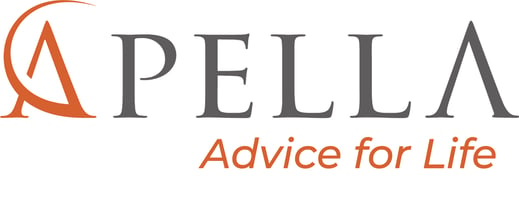Apella Wealth Blog

Funding Children’s Education & Planning for You First
Planning for college can be a daunting task for anyone and “3.6 million parents have taken out $103.6 billion in loans, according to federal 2021 data, with the average initial balance standing at nearly $29,0001.” Significant stress is put on parents to save / pay for their children’s education. Balancing this goal with other financial responsibilities like everyday expenses and saving for retirement can add to the anxiety of initiating a plan. Tuition costs continue to rise, making it harder to estimate how much to save.
Here are a few considerations when braving those waters:
1. Start saving early
Saving when your child is young, even a small amount each month, will be well worth it. The effect of compounding interest is significant and unlike saving for retirement, you only have 18 years to save for college. Charles Schwab illustrates the effect of delaying in the graph below:

2. How much should you save?
The age-old question of “how much is enough” haunts many on this journey. The age-old answer for this question is, “it depends.” It may not be necessary to save the entire amount of what you think college will cost for your child(ren). Students have many avenues available to them when beginning their future. Some may qualify for scholarships, some may choose community college or trade school, and some forgo school altogether. Consulting an advisor can help parents navigate how to determine the total estimated future costs and present savings needed paired with any available financial resources to attain their specific education funding goals.
3. Where should you save?
Using a mix of investments and account types is typically a sound strategy. Use 529 plans for some of the education goal. Many offer single investments based on age or target-date. These investments will automatically become more conservative as your child ages. This means spending less time monitoring that asset allocation or worse, trying to time it. 529 plans can also offer portfolios labeled aggressive, moderate, or conservative. These won’t change over time, so consult a financial planner to help monitor the mix.
For more flexibility, it is a good option for some of the savings to go into your brokerage account. Invest more long-term giving more flexibility if your child picks a different path. Brokerage accounts can also have a better variety of low-cost funds or ETFs to invest in than a 529 account.
4. Planning for you first.
While it's important to save for education, ensuring your retirement plan is solid should take precedence. Balancing both goals is ideal but maintaining a focus on retirement can provide a more secure financial future. You won't be able to borrow for your retirement and having sufficient funds is essential for a comfortable retirement. There are many other sources available to fund education. It’s a balancing act in getting the right size contributions towards your retirement and other goals while being intentional about planning for future college expenses. Your financial planner can and should be working with you to find the optimal balance for your situation.
While you should start saving before your children are old enough to understand what they may want to do in the future, don’t forget to include them in the conversation before the SUV is packed and headed down the road. High schools are talking to kids about college in freshman year. Start setting some expectations early, before they fall in love with the $70,000 a year private school 3,000 miles away.
The discussion should include:
- Realistic costs: in-state, out-of-state, and alternative trade & technical schools
- What are you willing to contribute? What you can afford and what you are willing to pay may not be the same thing.
- Your expectation for their role in this financial decision. Their pursuit of scholarship funds, part-time work, community college for the first 2 years, etc.
- What do they want to do and why? This will change every few months during high school for some kids, so continue the conversation over time.
- If loans will be part of your plan, be sure to talk with your child about who will be responsible for repaying the loan. A Sallie Mae study found that only “40% of borrowing families shared that they discussed who would be responsible for paying back student loans and 31% discussed who would be responsible for paying back parent loans3.”
There are many options and paths in this discussion based on your circumstances and your kids. The important step is to start the discussion and plan in advance.
Sources
1.“3.6 million parents have taken out $103.6 billion in loans, according to federal 2021 data, with the average initial balance standing at nearly $29,000” - https://www.businessinsider.com/parent-plus-loans-student-debt-interest-higher-education-2022-5
2. Graph - 8 Mistakes to Avoid When Planning for College Costs | Charles Schwab
3.“just 40% of borrowing families shared that they discussed who would be responsible for paying back student loans and 31% discussed who would be responsible for paying back parent loans” - HAP_2024.pdf (salliemae.com) - Sallie Mae 2024 pg. 10
Disclosures:
Apella Capital, LLC (“Apella”), DBA Apella Wealth is an investment advisory firm registered with the Securities and Exchange Commission. The firm only transacts business in states where it is properly registered or excluded or exempt from registration requirements. Registration with the SEC or any state securities authority does not imply a certain level of skill or training. Different types of investments involve varying degrees of risk, and there can be no assurance that the future performance of any specific investment, investment strategy, product or any non-investment-related content made reference to directly or indirectly in this material will be profitable, equal any corresponding indicated historical performance level(s), be suitable for your portfolio or individual situation, or prove successful. Due to various factors, including changing market conditions and/or applicable laws, the content may not be reflective of current opinions or positions. Please note the material is provided for educational and background use only. Diversification seeks to improve performance by spreading your investment dollars into various asset classes to add balance to your portfolio. Using this methodology, however, does not guarantee a profit or protection from loss in a declining market. Past performance does not guarantee future results. All data is from sources believed to be reliable but cannot be guaranteed or warranted.
No current or future client should assume that any discussion or information contained in this material serves as the receipt of, or as a substitute for, personalized investment advice. As with any investment strategy, there is the possibility of profitability as well as loss.
Apella Wealth does not provide insurance services or legal advice and nothing either stated or implied here should be inferred as providing such advice.
Related Articles
Financial and Legal Preparation for College Students
It has been a year of milestones in my home. My son graduated high school, turned 18, and started...Utilizing 529 Plans and Direct Payments to Educational Institutions for Estate Planning
Higher education not only offers a great way to better position your children and grandchildren for...
